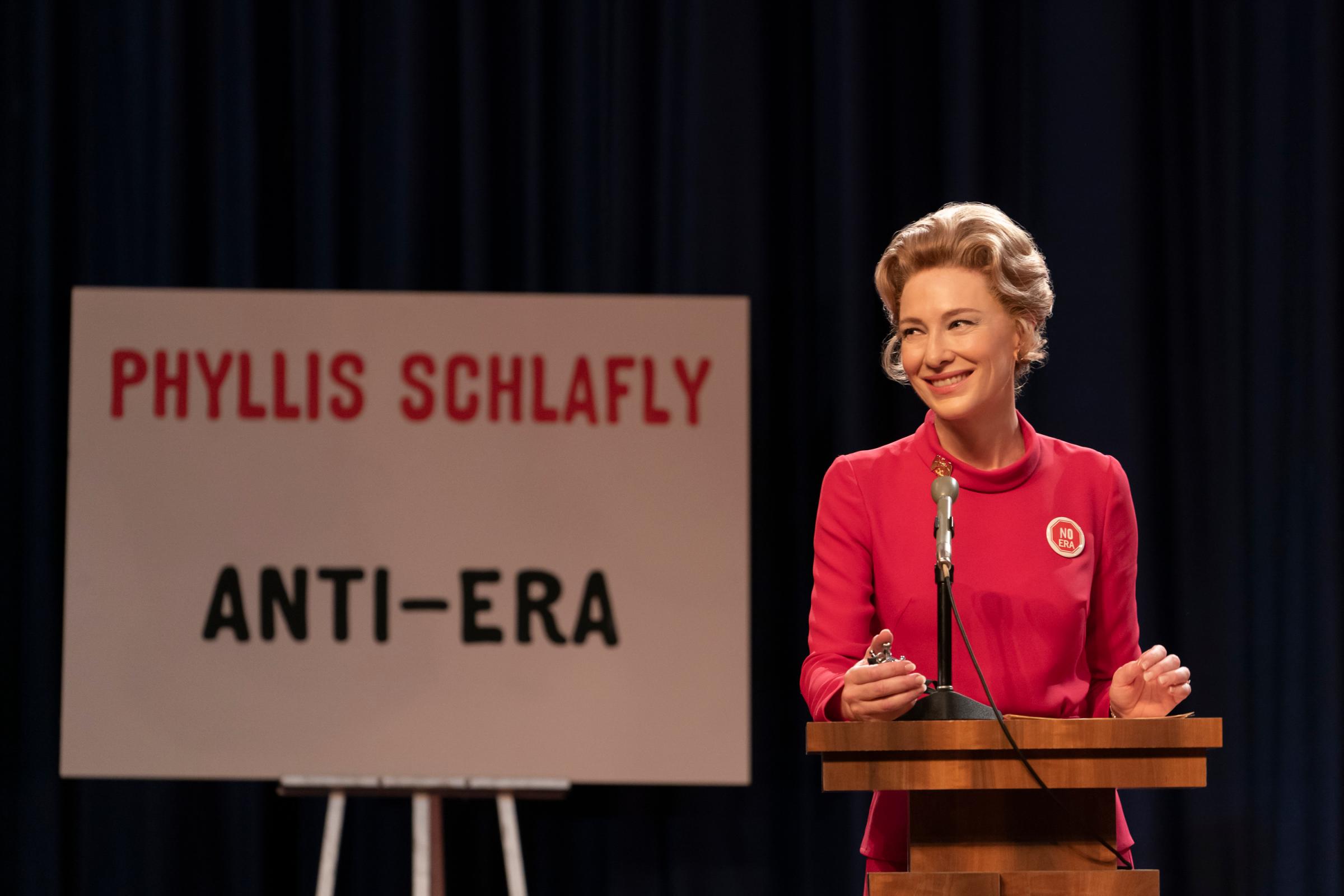Margaret Thatcher does an awful lot of crying in The Crown. Though the Prime Minister was known to shed a tear or two during her 11 years leading the United Kingdom, the show leans heavily on several scenes of the woman who came to be known as the “Iron Lady” overcome by emotion.
In real life, Thatcher’s legacy is polarizing, to say the least. Many conservatives idolize her for economic reforms that supercharged the U.K. economy. Suffice it to say, liberals do not share that sunny view. She stripped the United Kingdom of many of the social programs that helped the poor, and many liberal leaders blame her for Britain’s ensuing housing and economic crises. She fought doggedly against leveraging her country’s considerable influence to help end apartheid in South Africa and allegedly said the country should be “whites only.” Poverty and inequality both increased during her tenure. The Crown depicts some of these policy decisions, most effectively in episodes told from others’ points of view. One of them follows a man who suffers under Thatcher’s social programs, unable to find work so that he might get partial custody of his children. Another largely sticks with the Queen herself as she privately battles with Thatcher over apartheid. But the writers also attempt to soften Thatcher’s image with moments of humanity—hence the tears.
The fourth season of the sprawling Netflix series about the royal family tries to decipher two very different women who dominated headlines in England and abroad throughout the 1980s: Thatcher, played with a prim ferocity by the great Gillian Anderson, and Princess Diana, played by newcomer Emma Corrin. Lady Di will no doubt be the pull for most viewers—decades after her tragic death, people still clamor for insight into her catastrophic marriage to Charles and her contentious relationship with the royal family. One can debate The Crown’s sympathies—it never paints the Queen as an outright villain even if the series increasingly depicts her children as brats. But Diana’s story of victimhood is fairly straightforward. She married a man in love with another woman. She was just 20 when she did so. At this point in history, as time has buffed away the spiky parts of her character to something resembling sainthood, history and memory have made it hard to view Diana with any sort of nuance. The show is happy to oblige its audience with a heroic version of Diana who is quite literally a princess trapped in a castle with people who either ignore her or are downright cruel to her.
But Thatcher proves a more difficult figure for the series to pin down. And the same challenges writers face when portraying conservative women on narrative television extend to the way in which the media covers these women in real time. Just as The Crown struggles with Thatcher or Mrs. America wrestled with anti-women’s right’s activist Phylis Schlafly earlier this year, the modern news media struggle to make sense of women like Amy Coney Barrett and Melania Trump. Attempts to locate empathy in the name of feminism can overshadow the need for accountability when it comes to the real-world impact of these women’s beliefs and actions.
Margaret Thatcher, Phyllis Schlafly and the empathetic TV treatment

The Crown does not shy away from Thatcher’s own sexism—when she’s elected she tells the Queen there will be no female members of her cabinet, “obviously,” and several episodes later blatantly tells her own daughter that she prefers her son because her daughter—like the vast majority of women—is weak. She only promoted one woman to her cabinet in 11 years, a classic example of a woman who reaches the top rung only to pull the ladder up behind her so other women cannot join her.
But the show softens these moments by suggesting that Thatcher suffered at the hands of the patriarchy herself, even if she usually wouldn’t admit it. While Thatcher did in fact cook for her cabinet, the show chooses to depict this domestic activity (while conducting a meeting about whether to go to war, no less) over any number of other moments from her tenure—like, to name just one, when poll tax riots broke out in 1990 in response to her policies. Later, when her own cabinet members stage a coup against her, she and the Queen agree that sexism played a role in these men’s betrayal of their leader.
Puzzling over this yo-yo portrayal of Thatcher—who swings from cold-hearted capitalist to a woman struggling to maintain her dignity as she weeps over her change in fortune—I was reminded of the portrayal of Schlafly in FX’s Mrs. America earlier this year. Schlafly mounted a successful attack against Gloria Steinem, Shirley Chisholm, Bella Abzug and other influential feminists pushing for the Equal Rights Amendment in the 1970s. She allied herself with homophobes and the KKK (decisions that are touched on but never truly reckoned with in that show). Mrs. America takes pains to demonstrate that Schlafly was, like Thatcher, a victim of a sexist system that she couldn’t quite see—or willfully ignored. Her husband bristled when she became too powerful. In the show, she casts the sexual harassment she experiences as flattery in order to occupy the corridors of power with men. She struggles personally because she can’t form partnerships with other women without betraying her ideals.
As Sonia Saraiya wrote in Vanity Fair earlier this year, this isn’t a new problem for Hollywood. Saraiya points to the empathetic 2011 Thatcher biopic Iron Lady, and more recently, 2019’s Bombshell, the based-on-true-events film about Megyn Kelly and others making allegations of sexual harassment against Fox News head Roger Ailes. That movie doesn’t even bother to try to reconcile Kelly’s feminist acts with her conservative views. (In reality, Kelly might balk at the description of what she did as a feminist act, even though the basic definition of feminism is promoting equal rights for women, which speaking out against sexual harassment surely does.) Many people want to think of groundbreaking women like Thatcher as feminist icons, not women who actively disliked being defined by their gender and, almost as if in compensation, didn’t support the social programs like child care that most help working women. The innate problem with the Hollywoodification of these stories, as Saraiya puts it, is that “characterization is an attempt to evoke empathy. When Hollywood takes on conservative women, the empathy often feels grafted on, sometimes shamelessly.”
That’s not to say that these women ought to be cackling villains either. A complex portrayal is almost always preferable to a flat character, present only to be pilloried by the hero. But these same showrunners make far less effort to write controversial male characters with similar moments of humanity. In this season of The Crown, alone, Prince Andrew, Margaret Thatcher’s son Mark and Thatcher’s own cabinet members get unsubtle villain edits with no moment of grace to redeem them. Even Prince Charles, who in previous seasons was an ignored child to be pitied, veers dramatically into the realm of callous cruelty this season in his relationship with Diana, with little explanation or insight into why exactly he acts so monstrously toward her. Similarly, the patriarchal figures who fight the feminists in Mrs. America—or even put down Schlafly—never get moments of grace or humanization. When it comes to conservative characters—male or female—writers tend to vilify or sympathize, respectively. In these shows, they rarely find the human ground in between.
Free Melania, Amy Coney Barrett and the mantle of feminism

This conflict isn’t unique to our fictional portrayals of historical figures. Some media outlets have, in recent years and months, struggled with how to frame conservative women. Left-leaning thinkers on Twitter long shared fantasies that First Lady Melania Trump was more liberal and, possibly, feminist than she let on, a hostage and a rebel in a conservative White House—or at least a helpless Belle to Trump’s beast, in no way a potent conservative force herself. “Free Melania” became a meme. Those versed in feminism’s sartorial history theorized that Melania’s choice to wear a pussy-bow blouse to her husband’s debate was a secret feminist commentary on the “grab her by the pussy” sexual assault scandal. Pundits read her face like tea leaves every time she rolled her eyes or swatted the President’s hand away. But last month, leaked audio of Melania Trump expressing indifference over children being separated from their children at the border dashed that hope, for the few still hanging onto it. And some pointed out that it was infantilizing to assume she wasn’t by her husband’s side of her own volition—that, yes, a woman could share those beliefs, too.
This hesitation to call out conservative women for their complicity in policies that, in the view of many, at least, hurt women can open the door for conservatives to call liberals hypocrites whenever they disagree with a conservative woman. Just look at the Supreme Court confirmation of Amy Coney Barrett, a woman who has openly expressed that she is anti-abortion rights, and, based on her legal writings, does not believe that the Constitution guarantees women equal protection before the law. During her confirmation, the Trump administration drew focus onto Coney Barrett’s seven children, pushing a narrative that some construed as suggesting that working mothers who struggle to balance work and childcare must be lazy, rather than victims of a system totally indifferent to their success or even survival. (The United States is the only developed country that does not offer parental leave and one of the few that does not offer universal childcare. Unlike in several countries in Europe, having a child in America is closely linked with a risk of poverty.)
Republican senators have tried to co-opt the language of feminism to praise Coney Barrett, calling her “an inspiration to millions of young women in this country,” as Thom Tillis of North Carolina put it. Trump has directly compared her to Ruth Bader Ginsburg—a woman who began her legal career arguing for equal rights for working women in front of the Supreme Court—as if the fact that they are both accomplished women negates the fact of their starkly opposed social and legal views. Coney Barrett’s fans sporting shirts that read “Notorious A.C.B.” reinforce this false equivalency.
In turn, feminists are criticized if they question the political views of a woman. A story in Politico claimed the judge as a “feminist icon.” An op-ed in The Hill asks, “What Happened to Democrats Supporting Women?” The National Review declares that “Feminists Flip on ‘Nasty Woman,” that merely questioning Coney Barrett’s political views is sexist. In fairness, many other media outlets have spilled plenty of digital ink explaining that being a feminist doesn’t mean simply supporting all female political figures; it means supporting those who actually help women—and certainly not those whose views would harm them.
Whether on TV shows or in the news, the credit Schlafly, Thatcher and Coney Barrett get for breaking into the boys’ club often comes without sufficient meditation on the long-term implications of those individual victories. Namely, that those women have promoted and enacted policies to create near-insurmountable roadblocks to other women who might otherwise break into that same boys’ club themselves. Painting a feminist gloss over their damaging policies muddles our understanding of women’s rights. Thatcher, for one, would have hated being called a feminist—and on that point, at least, she would have been right.
More Must-Reads From TIME
- The 100 Most Influential People of 2024
- The Revolution of Yulia Navalnaya
- 6 Compliments That Land Every Time
- What's the Deal With the Bitcoin Halving?
- If You're Dating Right Now , You're Brave: Column
- The AI That Could Heal a Divided Internet
- Fallout Is a Brilliant Model for the Future of Video Game Adaptations
- Want Weekly Recs on What to Watch, Read, and More? Sign Up for Worth Your Time
Write to Eliana Dockterman at eliana.dockterman@time.com